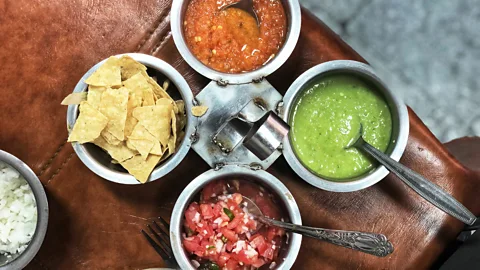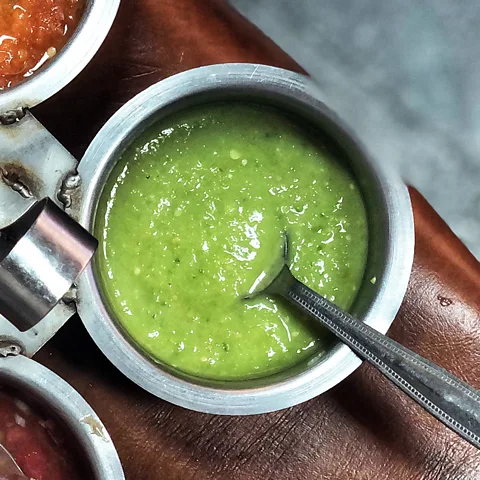Guacachile: A time-honoured guacamole lookalike
 Jane Sigal
Jane SigalKnown in Mexico as "fake guacamole", guacachile is a silky, delicious sauce made with just four ingredients – not including avocados. Can diners tell the difference?
Maybe it's time to cut back on the guacamole and try something different this Cinco de Mayo. High prices, extreme water shortages, illegal deforestation and "avocado hand" all make its main ingredient, the globally popular green fruit, a bit less appealing.
Fortunately, there's a time-honoured guacamole lookalike that even has the same linguistic roots in Nahuatl, the language of the Aztecs. It's called guacachile and it's a spicy, rich Mexican sauce, spread and dip that's as creamy as its inspiration – except it's made with jalapeños instead of avocados.
The precise genesis of guacachile is unclear, but the earliest innovators were probably Mexican taqueros (taco vendors) who responded creatively about 10 years ago when faced with the rising cost of avocados. Jalapeños have the advantage of being green, cheap and bountiful, and when blended with onions and oil, form a mixture remarkably like the pourable guacamole often used as a taco topping. What is clear is the firestorm that erupted around falso guacamole ("fake guacamole", another name for guacachile), in 2019, when it became more widely known that taco vendors across Mexico were serving it.
Liz Maya's guacachile represents the super-simple recipe's most essential form. The head prep cook at Oaxaca's Criollo restaurant prepares her version with only four ingredients that are available in any supermarket: jalapeños, onions, vegetable oil and salt. She simmers the chillies and onion in oil until soft, then purées the mixture in a blender with salt until it's velvety and pale green.
Because guacachile is basically just watery vegetables and fat held together without eggs, flour or other starches, the cloud-like sauce is rather delicate. Yet, Maya has a few tricks to keep it from separating.
First, she recommends making sure the ingredients are at room temperature ahead of blending. Then, she drains the cooked vegetables, reserving the oil, and purées the vegetables before gradually adding the oil, as when making mayonnaise.
However, these are the refinements of a chef at an ambitious restaurant. In fact, Mexicans usually taste the sauce first at a taquería (taco stand) or in their mother's kitchen – and now it's also a big hit at burger stands. Guacachile is not taught in cooking schools and doesn't appear in books; cooks often pick up the details from YouTube.
 Jane Sigal
Jane SigalAnother indicator of its humble origin is the name. Not everyone recognises the name "guacachile", since in addition to being called falso guacamole, it's also known as salsa taquera (taco vendor's salsa), guacamole taquero (taco vendor's guacamole), salsa verde cremosa (creamy green sauce), guacamole sin aguacate (without avocado) and salsa verde en aceite (emulsified green sauce), plus countless other monikers.
Regardless of its name, everybody in Mexico now knows what it is and one of its defining characteristics: spiciness. "You want to taste the chilli," says Evelia (Doña Eve) Reyes, whose successful takeaway in Oaxaca inspired the fine-dining restaurant Origen, where she's now in the kitchen almost every day.
"We eat hot," agrees Nelly Cervantes Martínez, a fresh juice maker in the city's La Noria market. There are a lot of similar condiments in Mexican cooking but they're not the same: pickled jalapeños, for instance, are vinegar-y, and salsa verde, which is also green and spicy, is not emulsified and creamy like guacachile.
Fieriness being one of guacachile's key pleasures, a central variation centres on playing with the burn. Reyes amps up the fire by replacing all or some of the jalapeños with serrano chillies. Maya's baseline guacachile, however, calls for removing the piquant chilli seeds and fleshy ribs. She also suggests swapping in green bell pepper for part of the jalapeños, while Cervantes Martínez tames the heat with zucchini.
Whatever the divergences, something about guacachile's frothy spiciness makes it an extraordinary sidekick. In addition to tacos and burgers, it's particularly good with tortas (sandwiches); char-grilled meat and fish; and crisp fried foods like tacos dorados (deep-fried rolled tacos), tostadas (cracker-like corn tortillas), fried chicken and tortilla chips.
Taqueros may have invented guacachile, but restaurant chefs are elevating the sauce and adding their own twists. At Pastelería Maque in Mexico City's chic Condesa neighbourhood, cream cheese replaces some of the oil for extra lushness. At Criollo, Maya makes a superb, more complex version with ripe red jalapeños and a pinch of cumin seed, and the sauce is likely to be a component in a plated dish rather than a condiment.
Still, names like "fake guacamole" suggest a prejudice against this delectable sauce. Can diners really tell the difference anyway? Chef Carlos Vásquez of Oaxaca's Taco Sireno insists that Mexicans can distinguish the two, but not foreigners. And yet, Jocsan Reyes Arias, owner of Borona Lonchería in Mexico City's trendy Roma neighbourhood, has a different take: "People always think my salsa has avocado. But no. It's falso guacamole."
 Jane Sigal
Jane SigalIf Maya is preparing a large quantity or wants to make the guacachile ahead of time, she refrigerates the cooked ingredients and then blends as needed.
Makes about 1 cup (250 ml)
Ingredients
¼ cup (60 ml) neutral oil, such as grapeseed
6 jalapeños, stemmed, seeded and sliced lengthwise
½ small white onion, sliced
1 tsp salt
Method
Step 1
In a large skillet or frying pan, warm the oil over medium heat until shimmering. Reduce the heat to medium low, add the jalapeños and onion and cook, stirring occasionally, until the vegetables are softened but not browned, about 10 minutes. Remove from the heat and let cool.
Step 2
Using a slotted spoon, add the jalapeños and onion to a blender (do not discard the oil in the pan). Season with salt. Cover and purée until mostly smooth. Gradually drizzle in the oil and purée until very smooth and light. Taste for seasoning, scrape into a bowl and serve.
BBC.com's World's Table "smashes the kitchen ceiling" by changing the way the world thinks about food, through the past, present and future.
--
For the best of BBC.com in your inbox every Friday, sign up to The Essential List newsletter for a handpicked selection of features, videos and can't-miss news.
